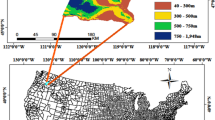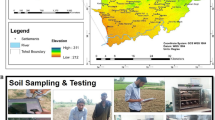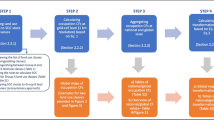Abstract
Spatial modelling of soil organic carbon stock (SOCS) and its future dynamics are essential for the sustainable management of terrestrial ecosystems and the planning of carbon sequestration measures. In this study, a spatial modelling approach of the dynamics of the SOCS distribution between 1985 and 2050 and its relationship with land use/land cover (LULC) change in the Béni-Mellal region was accomplished by performing a spatial regression using a multilayer perceptron (MLP) driven by 10 predictors and SOCS data from 40 soil samples. Predictors were extracted from Landsat 5 TM/8 OLI and Sentinel-2 MSI multispectral images and CA-Markov was used for geo-simulations predicting future dynamics. This result shows that the spatial distribution of SOCS and its temporal dynamics in terms of positive and negative variations are strongly linked to spatiotemporal changes in LULC. Over the period 1985–2018, the results showed both progressive variations in the soils of tree crops, unused land and soils in urban areas, slight variations in forest soils and significantly regressive variations in the soils of cropland (− 606 kg.106). The future dynamics from 2018 to 2050 suggest a very significant positive evolution of the SOCS in forest soils with a rate of change of 35.6 kg.106, while the regressive evolution of the SOCS in cropland should continue at − 73.1 kg.106. Furthermore, the spatial autocorrelation results suggest that the spatial distribution of LULC units, topography and vegetation indices are the main factors influencing the quantitative distribution of SOCS in the study area, with correlations ranging from 0.8 to 0.94.











Similar content being viewed by others
Data availability
The datasets used can be made available upon request from the corresponding author (M. Oukhattar).
References
FAO. Soil is a non-renewable resource. 2015.
Lal R. Soil carbon sequestration impacts on global climate change and food security. Science. 2005;304:1623–7.
Xiong X, Sabine GD, Brenton M, Wade R, Willie GH, Nicolas BC. Interaction effects of climate and land use/land cover change on soil organic carbon sequestration. Sci Total Environ. 2014;493:974–82.
Bernoux M, Conceicao MD, Carvalho S, Volkoff B, Cerri CC. CO2 emission from mineral soils following land-cover change in Brazil. Glob Change Biol. 2001;7(7):779–87.
Hutchinson JJ, Campbell CA, Desjardins RL. Some perspectives on carbon sequestration in agriculture. Agric For Meteorol. 2007;142(24):1–302.
Yang RM, Zhang GL, Yang F, Zhi JJ, Yang F, Liu F, Zhao YG, Li DC. Precise estimation of soil organic carbon stocks in the northeast Tibetan plateau. Sci Rep. 2016;6:21842.
Yang S, Sheng D, Adamowski J, Gong Y, Zhang J, Cao J. Effect of land use change on soil carbon storage over the last 40 years in the Shi Yang River Basin, China. Land. 2018;7(1):11.
Beesley L. Carbon storage and fuxes in existing and newly created urban soils. J Environ Manag. 2012;104:158–65.
Wei ZQ, Wu SH, Zhou SL, Li JT, Zhao QG. Soil organic carbon transformation and related properties in urban soil under impervious surfaces. Pedosphere. 2014;24(1):56–64.
Golubiewski NE. Urbanisation increases grassland carbon pools: effects of landscaping in Colorado’s front range. Ecol Appl. 2006;16(2):555–71.
Raciti SM, Hutryra LR, Finzi AC. Depleted soil carbon and nitrogen stocks under impervious surfaces. Environ Pollut. 2012;164:248–51.
Ait Ouhamchich K, Karaoui I, Arioua A, Kasmi A, Elhamdouni D, Elfiraoui E, Arioua Z, Nazi F, Nabih N. Climate change trend observations in Morocco: case study of Beni Mellal-Khenifra and Darâa-Tafilalt regions. J Geosci Environ Prot. 2018;6:34–50.
El Jazouli A, Barakat A, Khellouk R, Rais J, El Baghdadi M. Remote sensing and GIS techniques for prediction of land use land cover change effects on soil erosion in the high basin of the Oum Er Rbia River (Morocco). Remote Sens Appl Soc Environ. 2018;13:361–74.
Barakat A, Ouargaf Z, Khellouk R, El Jazouli A, Touhami F. Land use/land cover change and environmental impact assessment in Béni-Mellal district (Morocco) using remote sensing and GIS. Earth Syst Environ. 2019;3:1–13.
Baki Y, Boutoial K, Medaghri-Alaoui A. The impact of climate change on water inflow of the three largest dams in the Beni Mellal-Khenifra region. E3S Web Conf. 2021;314:03002.
Heuvelink GB, Angelini ME, Poggio L, Bai Z, Batjes NH, van den Bosch R, Sanderman J. Machine learning in space and time for modelling soil organic carbon change. Eur J Soil Sci. 2021;72(4):1607–23.
Odebiri O, Mutanga O, Odindi J, Naicker R. Modelling soil organic carbon stock distribution across different land-uses in South Africa: a remote sensing and deep learning approach. ISPRS J Photogramm Remote Sens. 2022;188:351–62.
Ahmed IS, Hassan FA, Sulieman MM, Keshavarzi A, Elmobarak AA, Yousif KM, Brevik EC. Using environmental covariates to predict soil organic carbon stocks in Vertisols of Sudan. Geoderma Reg. 2022;31: e00578.
Sanderman J, Baldock JA, Dangal SR, Ludwig S, Potter S, Rivard C, Savage K. Soil organic carbon fractions in the Great Plains of the United States: an application of mid-infrared spectroscopy. Biogeochemistry. 2021;156(1):97–114.
Ahmadi A, Emami M, Daccache A, He L. Soil properties prediction for precision agriculture using visible and near-infrared spectroscopy: a systematic review and meta-analysis. Agronomy. 2021;11(3):433.
Mousavi SR, Sarmadian F, Omid M, Bogaert P. Three-dimensional mapping of soil organic carbon using soil and environmental covariates in an arid and semiarid region of Iran. Measurement. 2022;201: 111706.
Tang X, Xia M, Pérez-Cruzado C, Guan F, Fan S. Spatial distribution of soil organic carbon stock in Moso bamboo forests in subtropical China. Sci Rep. 2017;7(1):42640.
Yao X, Yu K, Deng Y, Zeng Q, Lai Z, Liu J. Spatial distribution of soil organic carbon stocks in Masson pine (Pinus massoniana) forests in subtropical China. Catena. 2019;178:189–98.
Szatmári G, Pásztor L, Heuvelink GB. Estimating soil organic carbon stock change at multiple scales using machine learning and multivariate geostatistics. Geoderma. 2021;403:115356.
Wang S, Zhuang Q, Jia S, Jin X, Wang Q. Spatial variations of soil organic carbon stocks in a coastal hilly area of China. Geoderma. 2018;314:8–19. https://doi.org/10.1016/j.geoderma.2017.10.052.
Nguemezi C, Tematio P, Silatsa FB, Yemefack M. Spatial variation and temporal decline (1985–2017) of soil organic carbon stocks (SOCS) in relation to land use types in Tombel area, South-West Cameroon. Soil Tillage Res. 2021;213:105114.
Zeraatpisheh M, Garosi Y, Owliaie HR, Ayoubi S, Taghizadeh-Mehrjardi R, Scholten T, Xu M. Improving the spatial prediction of soil organic carbon using environmental covariates selection: a comparison of a group of environmental covariates. Catena. 2022;208:105723.
Odebiri O, Mutanga O, Odindi J, Naicker R, Slotow R, Mngadi M. Evaluation of projected soil organic carbon stocks under future climate and land cover changes in South Africa using a deep learning approach. J Environ Manag. 2023;330:117127.
Martin MP, Orton TG, Lacarce E, Meersmans J, Saby NPA, Paroissien JB, Arrouays D. Evaluation of modelling approaches for predicting the spatial distribution of soil organic carbon stocks at the national scale. Geoderma. 2014;223:97–107.
Bae J, Ryu Y. Land use and land cover changes explain spatial and temporal variations of the soil organic carbon stocks in a constructed urban park. Landsc Urban Plan. 2015;136(April):57–67.
Shifaw E, Sha J, Li X, Jiali S, Bao Z. Remote sensing and GIS-based analysis of urban dynamics and modelling of its drivers, the case of Pingtan, China. Environ Dev Sustain. 2018;22(3):2159–86.
Obeidat M, Awawdeh M, Lababneh A. Assessment of land use/land cover change and its environmental impacts using remote sensing and GIS techniques, Yarmouk River Basin, north Jordan. Arab J Geosci. 2019;12(22):685.
Fathizad H, Taghizadeh-Mehrjardi R, Hakimzadeh Ardakani MA, Zeraatpisheh M, Heung B, Scholten T. Spatiotemporal assessment of soil organic carbon change using machine-learning in arid regions. Agronomy. 2022;12(3):628.
Yan Y, Zhang C, Hu Y, Kuang W. Urban land-cover change and its impact on the ecosystem carbon storage in a Dryland city. Remote Sens. 2015;8(1):6.
Taghizadeh-Mehrjardi R, Neupane R, Sood K, Kumar S. Artificial bee colony feature selection algorithm combined with machine learning algorithms to predict vertical and lateral distribution of soil organic matter in South Dakota, USA. Carbon Manag. 2017;8(3):277–91.
Nurmiaty, Sumbangan B, Samsu A. GIS-based modelling of land use dynamics using cellular automata and Markov chain. J Environ Earth Sci. 2014;4(4):2224–3216.
Huong NTT, Phuong NTT. Land use/land cover change prediction in Dak Nong Province based on remote sensing and Markov Chain Model and Cellular Automata. J Vietnam Environ. 2018;9(3):132–40.
Baker WL. A review of models of landscape change. Landsc Ecol. 1989;2:111–33. https://doi.org/10.1007/BF00137155.
Muller MR, Middleton J. A Markov model of land-use change dynamics in the Niagara Region, Ontario, Canada. Landsc Ecol. 1994;9:151–7.
Sharjeel M, Zahir A, Mateeul H, Badar MG. Monitoring and predicting land use/landcover change using an integrated Markov chain & multilayer perceptron models: a case study of Sahiwal Tehsil. J GeoSpace Sci. 2016;1(2):43–59.
Hazhir K, Javad J, Jabbar K, Parisa A. Monitoring and prediction of land use/land cover changes using CA-Markov model: a case study of Ravansar County in Iran. Arab J Geosci. 2018;11(592):1–9.
Emadi M, Taghizadeh-Mehrjardi R, Cherati A, Danesh M, Mosavi A, Scholten T. Predicting and mapping of soil organic carbon using machine learning algorithms in Northern Iran. Remote Sens. 2020;12(14):2234.
Kılıc M, Gundoğan R, Gunal H, Cemek B. Accuracy assessment of Kriging, artificial neural network, and a hybrid approach integrating spatial and terrain data in estimating and mapping of soil organic carbon. PLoS One. 2022;17(5):e0268658.
Pouyat RV, Yesilonis ID, Nowak DJ. Carbon storage by urbain soils in the United States. J Environ Qual. 2006;35(4):1566–75.
Hutyra LR, Yoon B, Alberti M. Terrestrial carbon stocks across a gradient of urbanisation: a study of the Seattle, WA region. Glob Change Biol. 2011;17(2):783–97.
Kaye JP, McCulley RI, Burke IC. Carbon Fluxes, nitrogen cycling, and soil microbial communities in adjacent urban, native, and agricultural ecosystems. Glob Change Biol. 2005;11(4):575–87.
Mestdagh I, Sleutel S, Lootens P, Van Cleemput O, Carlier L. Soil organic carbon stocks in verges and urban areas of Flanders, Belgium. Grass Forage Sci. 2005;60(2):151–6.
Edmonds JL, O’Sullivan OS, Inger R, Potter J, McHugh N, Gaston KJ, Leake JR, Bond-Lamberty B. Urban tree effects on soil organic carbon. PLoS One. 2014;9(7): e101872.
Ministry of Agriculture, Fisheries, Rural, Development, Water and Forests.: Green Moroccan Plan. 2008.
Townshend JR, Masek JG, Huang C, Vermote EF, Gao F, Channan S, Sexton JO, Feng M, Narasimhan R, Kim D, Song K, Song D, Song XP, Noojipady P, Tan B, Hansen MC, Li M, Wolfe RE. Global characterisation and monitoring of forest cover using Landsat data: opportunities and challenges. Int J Digit Earth. 2012;5(5):373–97.
Gadal, S.; Oukhattar, M.; Keller, C. and Houmma, I.: Spatio-temporal modelling of relationship between organic carbon content and land use using deep learning approach and several co-variables: application to the soils of the Beni Mellal in Morocco. In: Proceedings of the 9th International Conference on Geographical Information Systems Theory, Applications and Management, 2023; pp. 15-26. https://doi.org/10.5220/0011723000003473.
Ennaji W, Barakat A, Karaoui I, El Baghdadi M, Arioua A. Remote sensing approach to assess salt-affected soils in the north-east part of Tadla plain, Morocco. Geol Ecol Landsc. 2018;2(1):22–8.
Aghzar N, Berdai H, Bellouti A, Soud B. Ground water nitrate pollution in Tadla (Morocco). J Water Sci Rev Sci Educ. 2002;15(2):459–92.
Hunter EL, Power CH. An assessment of two classification methods for mapping Thames Estuary intertidal habitats using CASI data. Int J Remote Sens. 2002;23(15):2989–3008.
Girouard G, Bannari A, El-Harti A, Desrochers A. Validated spectral angle mapper algorithm for geological mapping: comparative study between quickbird and Landsat-TM, geo-imagery bridging continents Istanbul, Turkey. Environ Sci Math Geol. 2004;12(23):599–604.
Kruse FA, Lefkoff AB, Boardman JW, Heidebrecht KB, Shapiro PJ, Goetz AFH. The spectral image processing system (SIPS)-interactive visualisation and analysis of imaging spectrometer data. Remote Sens Environ. 1993;44(2–3):145–63.
Adams WA. The effect of organic matter on the bulk and true densities of some uncultivated podzolic soils. Eur J Soil Sci. 1973;24:10–7.
Cresswell HP, Hamilton GJ, et al. Bulk density and pore space relations. In: McKenzie NJ, et al., editors. Soil physical measurement and interpretation for land evaluation. Australian Soil and Land Survey Handbook. CSIRO; 2002. p. 35–58.
What is soil organic carbon? Agriculture and Food. 2022. https://www.agric.wa.gov.au/measuring-and-assessing-soils/what-soil-organic-carbon.
Total Organic Carbon, Fact Sheets. soilquality.org.au. https://www.soilquality.org.au/factsheets/organic-carbon.
Schneider F, Poeplau C, Don A. Predicting ecosystem responses by data-driven reciprocal modelling. Glob Change Biol. 2021;27(21):5670–9. https://doi.org/10.1111/gcb.15817.
Lugato E, Panagos P, Bampa F, Jones A, Montanarella L. A new baseline of organic carbon stock in European agricultural soils using a modelling approach. Glob Change Biol. 2014;20(1):313–26.
FAO. Measuring and modelling soil carbon stocks and stock changes in livestock production systems: Guidelines for assessment (Version 1). Livestock Environmental Assessment and Performance (LEAP) Partnership. Rome, FAO. 170 pp. Licence: CC BY-NC-SA 3.0 IGO. 2019.
Pacini L, Arbelet P, Chen S, Bacq-Labreuil A, Calvaruso C, Schneider F, Arrouays D, Saby NPA, Cécillon L, Barré P. A new approach to estimate soil organic carbon content targets in European croplands topsoils. Sci Total Environ. 2023;900:165811. https://doi.org/10.1016/j.scitotenv.2023.165811.
Garcia-Gaines, A., Frankenstein, S.: USCS and the USDA soil classification system. In: US army corps of engineers. 2015; pp. 46
Gidey E, Dikinya O, Sebego R. Cellular automata and Markov Chain (CA-Markov) model-based predictions of future land use and land cover scenarios (2015–2033) in Raya, northern Ethiopia. Model Earth Syst Environ. 2017;3:1245–62.
Gadal, S., Oukhattar, M., Otobo, S.O.: Multitemporal recognition of built-up area and land cover changes using machine learning approach in the Metropolis of Aix-Marseille-Provence in France. In: 2023 Joint Urban Remote Sensing Event (JURSE), Heraklion, Greece. 2023; pp. 1-4. https://doi.org/10.1109/JURSE57346.2023.10144184.
Rwanga S, Ndambuki J. Accuracy assessment of land use/land cover classification using remote sensing and GIS. Int J Geosci. 2017;8:611–22. https://doi.org/10.4236/ijg.2017.84033.
Emamgholizadeh S, Esmaeilbeiki F, Babak M, Zarehaghi D, Maroufpoor E, Rezaei H. Estimation of the organic carbon content by the pattern recognition method. Commun Soil Sci Plant Anal. 2018;49(17):2143–54.
Muchena R. Estimating soil carbon stocks in a dry Miombo ecosystem using remote sensing. For Res Open Access. 2017. https://doi.org/10.4172/2168-9776.1000198.
Zomer RJ, Neufeldt H, Xu J, Ahrends A, Bossio D, Trabucco A, Wang M. Global tree cover and biomass carbon on agricultural land: the contribution of agroforestry to global and national carbon budgets. Sci Rep. 2016;6(1):29987.
Bogunovic I, Viduka A, Magdic I, Telak LJ, Francos M, Pereira P. Agricultural and forestland-use impact on soil properties in Zagreb periurban area (Croatia). Agronomy. 2020;10(9):1331.
Laganière J, Déni AA, David P. Carbon accumulation in agricultural soils after afforestation: a meta-analysis. Glob Change Biol. 2010;16(1):439–53.
Ghimire P, Bhatta B, Pokhrel B, Kafle G, Paudel P. Soil organic carbon stocks under different land uses in Chure region of Makawanpur district, Nepal. SAARC J Agric. 2019;16:13–23. https://doi.org/10.3329/sja.v16i2.40255.
Reicosky DC. Tillage-induced CO2 emissions and carbon sequestration: effect of secondary tillage and compaction. Conserv Agric Environ Farmers Exp Innov Socioecon Policy. 2003. https://doi.org/10.1007/978-94-017-1143-2_35.
Haddaway NR, Hedlund K, Jackson LE, et al. How does tillage intensity affect soil organic carbon? A systematic review. Environ Evid. 2017;6:30. https://doi.org/10.1186/s13750-017-0108-9.
Ramesh T, Bolan NS, Kirkham MB, Wijesekara H, Kanchikerimath M, Rao CS, Freeman OW II. Soil organic carbon dynamics: impact of land use changes and management practices: A review. Adv Agron. 2019;156:1–107.
Xiong X, Grunwald S, Myers DB, Ross CW, Harris WG, Comerford NB. Interaction effects of climate and land use/land cover change on soil organic carbon sequestration. Sci Total Environ. 2014;493:974–82.
Buraka T, Elias E, Lelago A. Soil organic carbon and its’ stock potential in different land-use types along slope position in Coka watershed, Southern Ethiopia. Heliyon. 2022;8(8):e10261.
Acknowledgements
We gratefully thank the Faculty of Science and Technology of Béni-Mellal, for having given us the means (transport and soil analysis laboratory) to carry out this work. We also like to thank Professor A. Barakat for his advice during the realisation of this study. Furthermore, we acknowledge support provided by the ECCOREV TOODS, MAMP-CNRS SOM, and CNES TOSCA TRISHNA projects.
Funding
This work was supported by the ECCOREV TOODS, MAMP-CNRS SOM and CNES TOSCA TRISHNA projects.
Author information
Authors and Affiliations
Corresponding author
Ethics declarations
Conflict of interest
All authors contributed to the production of the manuscript and declare no conflict of interest.
Consent to Publication
This manuscript is an extension of the proceedings of GISTAM 2023: 9th International Conference on Theory, Applications and Management of Geographic Information Systems. It has not been submitted to, nor is it under review in, any other journal or publication venue.
Additional information
Publisher's Note
Springer Nature remains neutral with regard to jurisdictional claims in published maps and institutional affiliations.
This article is part of the topical collection “Advances on Geographical Information Systems Theory, Applications and Management” guest edited by Lemonia Ragia, Cédric Grueau and Armanda Rodrigues.
Rights and permissions
Springer Nature or its licensor (e.g. a society or other partner) holds exclusive rights to this article under a publishing agreement with the author(s) or other rightsholder(s); author self-archiving of the accepted manuscript version of this article is solely governed by the terms of such publishing agreement and applicable law.
About this article
Cite this article
Gadal, S., Oukhattar, M., Keller, C. et al. Spatiotemporal Modelling of Soil Organic Carbon Stocks in a Semi-Arid Region Using a Multilayer Perceptron Algorithm. SN COMPUT. SCI. 5, 561 (2024). https://doi.org/10.1007/s42979-024-02872-8
Received:
Accepted:
Published:
DOI: https://doi.org/10.1007/s42979-024-02872-8




